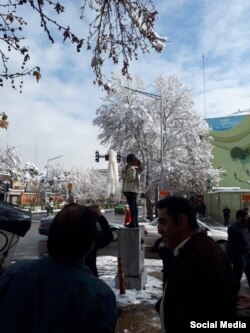Protesting mandatory hijab has reportedly spread to other large cities in Iran. Several women in Mashhad, the holy Shi’ite city, and in Esfahan and Shiraz have followed the footsteps of a woman who has become the symbol of resistance against Iran’s strict dress code.
On December 27, a day before the outbreak of widespread protests against poverty, unemployment, and dictatorship in Iran, an unidentified woman climbed on top of an electricity box on one of Tehran’s busiest streets, Enqelab (Revolution) Avenue, removed her head scarf, and began waving it in the air. A video clip of the woman, who appears to be in her early 30s, quickly went viral, and her act became a symbol of Iranian women’s resistance to the compulsory hijab. Known by the nickname of the Girl of Revolution Street, she has been praised as a courageous defender of women’s rights.
Two days later, the woman was arrested but, according to prominent lawyer and former political prisoner Nasrin Sotoudeh, she was freed, presumably on bail.
“I hope they don't fabricate a legal case to harm her for exercising her basic rights. She has done nothing wrong to deserve prosecution. Hands off her, please," Sotoudeh said.
Although the first Girl of Revolution Street has not yet been officially identified, social media users in Iran have referred to her as Vida Movahed, a 31-year-old mother.
Another woman, Narges Hosseini, later appeared performing a similar act in the heart of Tehran.
Sotoudeh accepted Hosseini’s request to defend her. She told Radio Farda that that the charges against Hosseini were not yet known, but the judge has issued a bail of $140,000.
Meanwhile, based on social media reports, women in Mashhad, Esfahan, Shiraz and other cities have followed suit and emerged as Girls of Revolution Street.
On January 31, an image of a women went viral on social media, showing a woman wearing a chador (a head-to-toe covering praised by Iranian authorities as the best hijab), standing on an electricity box in Mashhad waving a headscarf tied to a long stick.
In response, women who wear the chador have reiterated on social media accounts that although they have chosen to wear it freely, they are against compulsory hijab.
One of the pictures show the original electricity box on Revolution Street inscribed with a sentence that says, “There is no dress code at this spot,” and a police car parked nearby.
As the number of Revolution Street Girls increase it would pose a problem for authorities to arrest everyone. In a new video, an elderly woman, who can hardly walk, climbs a platform and with her walking stick takes off her headscarf and starts waving it in the air.
Hijab has a complicated history in Iran. The chador was forbidden in 1936 during the reign of Reza Shah, the founder of the Pahlavi dynasty. But, in 1941, he abdicated to Crown Prince Mohammad-Reza, who relaxed the dress code and allowed women to wear the hijab if they chose.
Just a few months after the 1979 Islamic Revolution, despite mass protests, a law forcing women to not only cover their heads but also wear loose clothing came into effect. The law was enforced with brute force on the streets until all women felt no other alternative but to follow the dress code.




